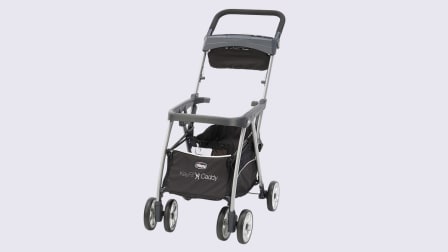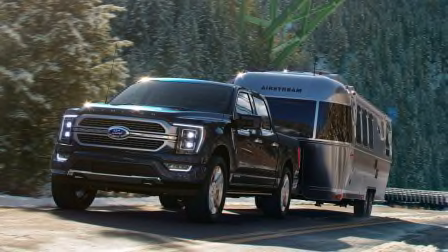Get Around Town More Easily
Whether you're grabbing some groceries or biking across town, we have the tips and tools to take you there
When you shop through retailer links on our site, we may earn affiliate commissions. 100% of the fees we collect are used to support our nonprofit mission. Learn more.

Want to make it easier to carry your goodies home from the bakery up the hill? Walk to the coffee bar a few blocks away? Or wait in line with a package on a busy day at the post office? The right gear can make all of this much more comfortable as well as safer.
There’s a growing number of well-designed, well-priced tools out there to help. These include personal shopping carts that are easy to maneuver, even when full of groceries. Rollators with sturdy seats so that you can take a brief break while on a walk. E-bikes that make going uphill a breeze. Here, from CR’s tests and outside experts, is a rundown on what’s new and useful to help you get where you want to go, on foot or by bicycle.
Walking
Walking poles, cane, shopping cart, rollator? What you pick should fit your body and your needs, says Nancy Gell, PhD, a physical therapist at the University of Vermont College of Nursing and Health Sciences. Good news: Some of the mobility tools below are covered by insurance.
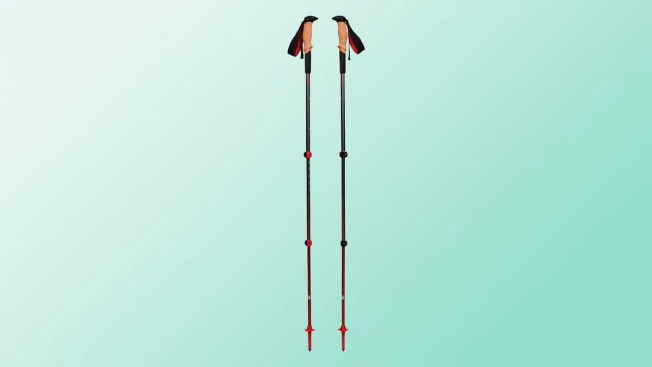
Source: Black Diamond Source: Black Diamond
Canes
They come in numerous styles, including the rustic wooden beauties at websites such as Brazos Walking Sticks and endlessly customizable ones from Neo Walk. Looks aside, a cane’s essential purpose is to take some weight off a sore or injured knee or hip, says Christine Childers, PhD, director of physical therapy at the University of Arizona College of Medicine in Tucson. They can also steady your balance if you’re feeling wobbly.
Choosing right: For most people, an offset cane, which has a curved top that can bear some of your weight, can go a long way in making a walk more comfortable. The experts we interviewed say a height-adjustable lightweight aluminum or carbon fiber cane with a nonslip rubber tip, such as the Mosaic Stained Window Offset Walking Cane With Comfort Grip ($30, Royal Canes, Amazon), is generally best. For convenience, a folding cane like the 7.6-ounce Leki Super Micro Adjustable Travel Cane ($74, Amazon) can be stashed in your bag and pulled out when you need it.
Shopping Carts
Out walking and spot that hard-to-find flavor of your favorite seltzer? A personal shopping cart can make it much easier to tote a case—or any other heavy or bulky items—back home. And because they’re more compact than typical supermarket shopping carts, they’re simpler to navigate in crowded store aisles.
Choosing right: For optimal maneuverability, look for a cart that has swiveling front wheels, like those on the Versacart Transit Utility Cart ($84, Wayfair, Amazon) and the Pipishell Shopping Cart ($70, Amazon, Walmart). The Pipishell also has height-adjustable handles. A cart with its own removable shopping bag at waist height, such as the Joovy Boot ($230, Joovy, Amazon, Home Depot, Lowes, Target), eliminates the need to bend far over to lift out groceries. And if you’ll be going up any stairs, consider a tri-wheel design—which has three rotating wheels on “spokes” at the back of the cart—like those on the Mount-it Fabric Rolling Stair Climber ($55, Home Depot).
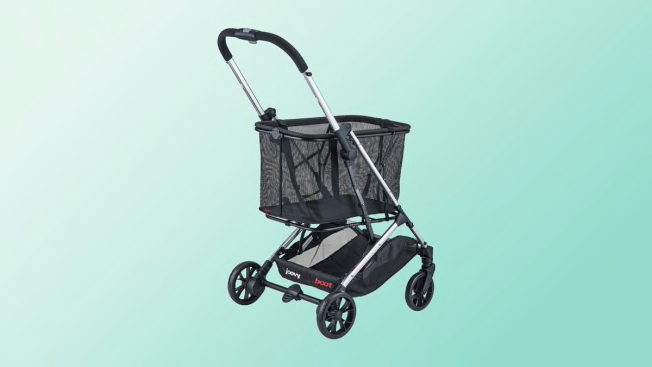
Photo: Joovy Photo: Joovy
Rollators
Want to be able to take a break while you’re out and about? Consider a rollator, a kind of rolling walker that usually has a seat, along with two fixed wheels in the back and two that swivel in front. If you’re standing for longer than you’d like, you can park the rollator against a wall or fence, lock the wheels, and sit. These can be a boon if you tend to get out of breath while walking—and for those who have pain in their knees or hips, says Cameron Hernandez, MD, a professor of internal medicine, geriatrics, and palliative medicine at the Icahn School of Medicine at Mount Sinai in New York City.
Choosing right: You’ll want a padded seat with back support and a basket. Look for front wheels that swivel well without wiggling, Hernandez says, to help you negotiate sidewalk cracks and bumps and doorsills. Make sure it’s easy to use the hand brakes’ locking mechanism, which you’ll need when you sit. Options include the Nova Medical Products Express Rollator Walker ($260, Amazon) and the Medline Premium Empower Folding Mobility Rollator Walker ($151, At Home, Amazon, Home Depot). Both fold up tightly for easier transport and space-saving storage. The Nova also has all-terrain wheels.

Source: Nova Source: Nova
Try These When You're on Foot
Bags, shoes, and clothing that can make an around-town walk a lot more enjoyable.
Bag for extras: With a reusable tote, you’ll always be able to load up at the farmers market. The machine-washable Baggu Tote Bag ($14, Baggu, Amazon), fits compactly into its own carrying case, as does the SYZY Crossbody Packable Travel Tote ($25, SYZY Universe, Amazon).
Hands-free pack: For carrying a few necessities, Karen Jacobs at Boston University recommends a lightweight backpack with padded shoulder straps and a hip strap. One that may fit the bill is the 18-inch REI Coop Flash 18 ($50, REI).
Reflective wear: The National Safety Council advises that walkers wear bright or reflective clothing for visibility. You can choose hats and other accessories, T-shirts, and jackets, including this can’t-miss-seeing-it lightweight L.L.Bean Bright Multisport Jacket ($99, Men’s, Women’s).
Supportive shoes: Stability is key in walking shoes, says Timothy J. Miller, DPM, a podiatrist in Orlando, Fla. So is comfort. He suggests footwear with stiff soles and a back that’s rigid, not soft. This should reduce any foot pain and “stress and strain on the joints and ligaments,” Miller says. Also good: a deep tread on the soles for traction to help prevent falls. Shoes that may work well include the Asics Gel Kayano ($160, Men’s, Women’s), the Brooks Ariel ($160, Brooks Running, Amazon), and the Hoka Arahi ($145, Hoka), according to Miller.
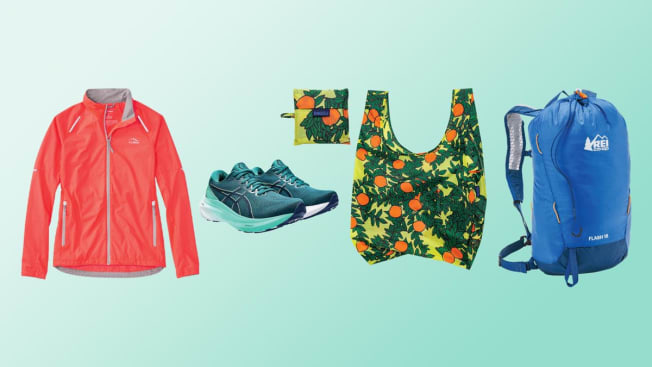
Source: Manufacturers Source: Manufacturers
Cycling
Riding a bike for doing errands or visiting friends—or just fun—is easier on your hips and knees than walking, and it can strengthen your heart and lungs. Whether you use an electric bike or a conventional one may depend on where you ride, what you want to spend, and your comfort level.
See Consumer Reports’ Electric Bike ratings and buying guide.
E-Bikes
With an electric motor that can assist you while you’re pedaling—or, in models with a throttle, replace pedaling altogether—an e-bike can be a good option if you tire while riding. They tend to be pricier and heavier than a conventional bicycle.
Choosing right: Jeffrey E. Herrick, PhD, director of the University of Lynchburg Active Aging Program, recommends a Class 1 or Class 2 e-bike for older adults. (You might want to get your doctor’s okay, too.) Motors on Class 1 e-bikes turn on only when you pedal and cut out when your speed goes over 20 mph. Class 2 e-bikes also feature electric assist up to 20 mph. Their motors can be activated by pedaling or with a throttle control on the handlebar. For either class, consider a step-through frame—which has a low top tube or none at all—so you won’t have to lift your leg high to get on and off. Upright handlebars, a plush seat, and wide tires also add comfort. Take some practice spins in a traffic-free area before riding on the road. “When you add a motor, you’re [moving] a little quicker and things happen a little faster, and your reactions need to adjust,” Herrick says.
Conventional Bicycles
Several types of conventional bicycles are good picks for local trips. Comfort bikes, such as cruisers, have wide tires, cushy seats, and upright handlebars for a comfortable and steady ride. Upright adult tricycles tend to offer good stability and cargo space. One tricycle option: the Everyjourney Tricycle (Sixthreezero). Cruisers and tricycles are primarily for pavement and short distances. Hybrids, a mix of road bike and mountain bike, have lower handlebars and narrower tires but can handle gravel and dirt paths and go farther and faster. The smaller wheels on folding bikes (like the CR-rated Zizzo Euromimi Urbano, available at Target and Walmart for $430) let you get on and off more easily.
Choosing right: Look for a step-through design like that on the Schwinn Destiny Step-Thru Cruiser ($350, Amazon), and the Trek Electra Townie 7D 24 Step-Thru ($630, Trek). CR experts also recommend disc brakes. A gel or memory foam seat can make sitting more comfortable, and if you’ll be riding on hills, opt for a bike with multiple speeds. Thinking about a folding bike? Be sure it’s easy to fold, unfold, and carry.
E-Bikes and Cycling Gear
Here are a few of CR’s top-rated electric bikes, plus helmets and other accessories that can make your ride smoother and safer.
Class 1
Class 2
Folding
Get a Good Helmet
A bike helmet can significantly cut your risk of a head or brain injury in an accident. Look for protective technology, such as a Multi-Directional Impact Protection System (Mips) or WaveCel, which is designed to reduce the likelihood of a concussion. Try on a helmet you’re considering to check the fit, which should be snug, with the straps forming a V underneath and slightly forward of each earlobe. Check out some of our top-rated models.
See Consumer Reports’ bike helmet ratings and buying guide.
Carry Your Stuff With Ease
A compact saddle or handlebar bag can hold your wallet, phone, and other essentials. One option is the State Bicycle Co. Saddle Bag ($30, Amazon, State Bicycle), which attaches beneath and behind the bike’s seat.
Editor’s Note: This article also appeared in the May/June 2024 issue of Consumer Reports magazine.
*Prices in this article are those at the time of publication.


















